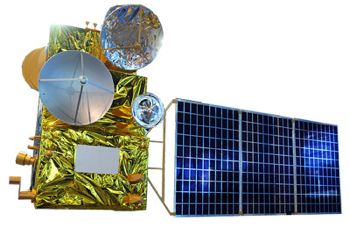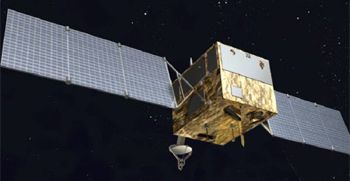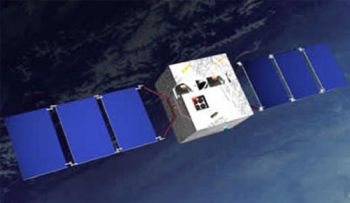
Home - Search - Browse - Alphabetic Index: 0- 1- 2- 3- 4- 5- 6- 7- 8- 9
A- B- C- D- E- F- G- H- I- J- K- L- M- N- O- P- Q- R- S- T- U- V- W- X- Y- Z
CAST968
 HY-2A Credit: Manufacturer Image |
AKA: Haiyang. Status: Operational 2002. First Launch: 2002-05-15. Last Launch: 2011-08-15. Number: 3 .
The multi-mission CAST968 bus was box-shaped with overall dimensions of 1.4 m x 1.1 m x 0.953 m. The spacecraft was designed and developed by the DFH (Dongfanghong Satellite Corporation Ltd.), a spin-off company of CASC, Beijing, China. The total deployed span of the solar panels on HY-1 was 7.5 m. The CAST968 platform was built on 8 subsystems: structure and mechanism, thermal control, attitude and orbit control, power supply, TT&C, antenna, housekeeping and electrical subsystems. The main structure of the bus was of aluminum honeycomb sandwich panels.
The spacecraft was 3-axis stabilized (Earth pointing) using bias momentum control. The AOCS (Attitude and Orbit Control Subsystem) used three magnetorquers and hydrazine propulsion for attitude control and orbit change maneuvers; the attitude accuracy was 0.4 deg in roll and pitch and 0.5 deg in yaw. Attitude sensing was provided by digital sun sensors and infrared Earth sensors.
The PPS (Power Supply Subsystem) provided of 510 W (EOL) power via two solar arrays of 5.67 m2 area. These charged two packs of NiCd batteries of 23 Ah for night phase power supply. The solar array articulation was provided by a small single-axis SADA (Solar Array Drive Assembly). Electric power distribution was provided at 28.5 V.
Active and passive thermal control kept the internal temperature between 0 and 45 deg C. This was accomplished using Multi-Layered Insulation, heat pipes, thermal control coatings, and electric heaters. Temperature was actively controlled for equipment sensitive to temperature, such as the sensor complement, the battery and the fuel tank.
The TT&C communication was in S-band, the downlink date rate 4 kbit/s, the uplink rate 2 kbit/s. A USB (Unified S-band) system was used for TT&C with GPS information for auxiliary orbit determination. There were two TT&C antennas to ensure communications with the ground at any satellite attitude configuration. The GPS provided a location accuracy of 50 m. The TT&C subsystem was also used for ranging measurements, determining the distance between the satellite and the ground station using Doppler signals. An onboard storage capacity of 80 Gbit was provided. All payload data were downlinked in X-band using QPSK modulation at a data rate of 6.654 Mbit/s, EIRP = 39.4 dBm. In the case of HY-1 the payload data were acquired at the Beijing and the Sanya ground receiving stations.
Main Characteristics
Mission types: Earth observation, communications, technology demonstration
Design life: 3-5 years
Orbit type: Sun-synchronous orbit
Spacecraft mass, power: 100-400 kg, 250 - 1000 W. In the HY-1 application the spacecraft mass was 442.5 kg (including 13 kg of propellant); payload mass = 87 kg
AOCS (Attitude and Orbit Control Subsystem)
Control type: bias-wheel and magnetic torquer control to achieve three-axis stabilityTTCS (Telemetry & Telecommand Subsystem)
Attitude determination accuracy (3-axis): <= 0.2 deg (3 sigma)
Attitude pointing accuracy (3-axis): <= 0.4 deg (3 sigma)
Attitude stability (3-axis): <= 0.1 deg (3 sigma)
Communication network: CAN (Controller Area Network) bus
Telemetry module mode: PCM/DPSK/PM
TT&C communication band: S-band
Telecommand data rate range: 2-8 kbit/s
Telemetry data rate range: 4-16 kbit/s
DTS (Data Transmission Subsystem): DT band (payload); X-band
Onboard data storage capacity: 128 Gbit
Max transmission rate: 320 Mbit/s
Data compression ratio: 8:1, 4:1
More at: Hy-2.
| SJ 5 Technology satellite built by DFH Satellite Co. Ltd of CAST for CAST, China. Launched 1999. Used CAST968A Bus. |
| HY-1 Chinese earth land resources satellite. Operational, launched from 2002.05.15 (Hai Yang 1). Oceanograpy satellite built by DFH Satellite Co. Ltd of CAST for CAST, China. Launched 2002 - 2007. Used CAST968B Bus. |
| HJ 1A, 1B (SMMS 1) Null |
| HJ 1C Earth observation, radar satellite built by DFH Satellite Co. Ltd of CAST for CRESDA, China. Launched 2012. Used CAST968B Bus. |
Family: Earth. Country: China. Launch Vehicles: Chang Zheng 2C, Chang Zheng 4B. Launch Sites: Taiyuan LC1, Taiyuan LC2. Bibliography: 12174.
 | HJ-1A Credit: Manufacturer Image |
 | HY-1B Credit: Manufacturer Image |
2002 May 15 - . 01:50 GMT - . Launch Site: Taiyuan. Launch Complex: Taiyuan LC1. LV Family: CZ. Launch Vehicle: Chang Zheng 4B.
- HY-1A - .
Payload: Haiyang 1. Mass: 367 kg (809 lb). Nation: China.
Agency: CASC.
Class: Earth.
Type: Earth resources satellite. Spacecraft: CAST968.
USAF Sat Cat: 27430 . COSPAR: 2002-024A. Apogee: 799 km (496 mi). Perigee: 785 km (487 mi). Inclination: 98.40 deg. Period: 100.70 min.
The HY-1 (Haiyang-1) marine observation satellite separated shortly after the FY-1D. The 360 kg HY-1 was based on the SJ-5 bus and carried an IR radiometer and CCD imager for oceanographic studies. Between May 21 and May 26, HY-1 lowered its orbit to 793 x 799 km using on-board propulsion.
2007 April 11 - . 03:27 GMT - . Launch Site: Taiyuan. LV Family: CZ. Launch Vehicle: Chang Zheng 2C.
- HY-1B - . Payload: Haiyang 1B. Mass: 443 kg (976 lb). Nation: China. Agency: CASC. Manufacturer: DFH. Class: Earth. Type: Sea satellite. Spacecraft: CAST968. USAF Sat Cat: 31113 . COSPAR: 2007-010A. Apogee: 815 km (506 mi). Perigee: 782 km (485 mi). Inclination: 98.60 deg. Period: 100.80 min. Oceanographic satellite equipped with a 10-band ocean color scanner, a 4-band CCD imager with 250-meter resolution, and an infrared water profile radiometer..
2011 August 15 - . 22:57 GMT - . Launch Site: Taiyuan. Launch Complex: Taiyuan LC2. LV Family: CZ. Launch Vehicle: Chang Zheng 4B.
- HY-2A - . Payload: Haiyang 2A. Mass: 443 kg (976 lb). Nation: China. Class: Earth. Type: Climate satellite. Spacecraft: CAST968. USAF Sat Cat: 37781 . COSPAR: 2011-043A. Apogee: 967 km (600 mi). Perigee: 966 km (600 mi). Inclination: 99.40 deg. Period: 104.40 min. Oceanographic satellite with a microwave radiometer, a radar altimeter and a radar scatterometer to monitor ocean conditions..
Back to top of page
Home - Search - Browse - Alphabetic Index: 0- 1- 2- 3- 4- 5- 6- 7- 8- 9
A- B- C- D- E- F- G- H- I- J- K- L- M- N- O- P- Q- R- S- T- U- V- W- X- Y- Z
© 1997-2019 Mark Wade - Contact
© / Conditions for Use